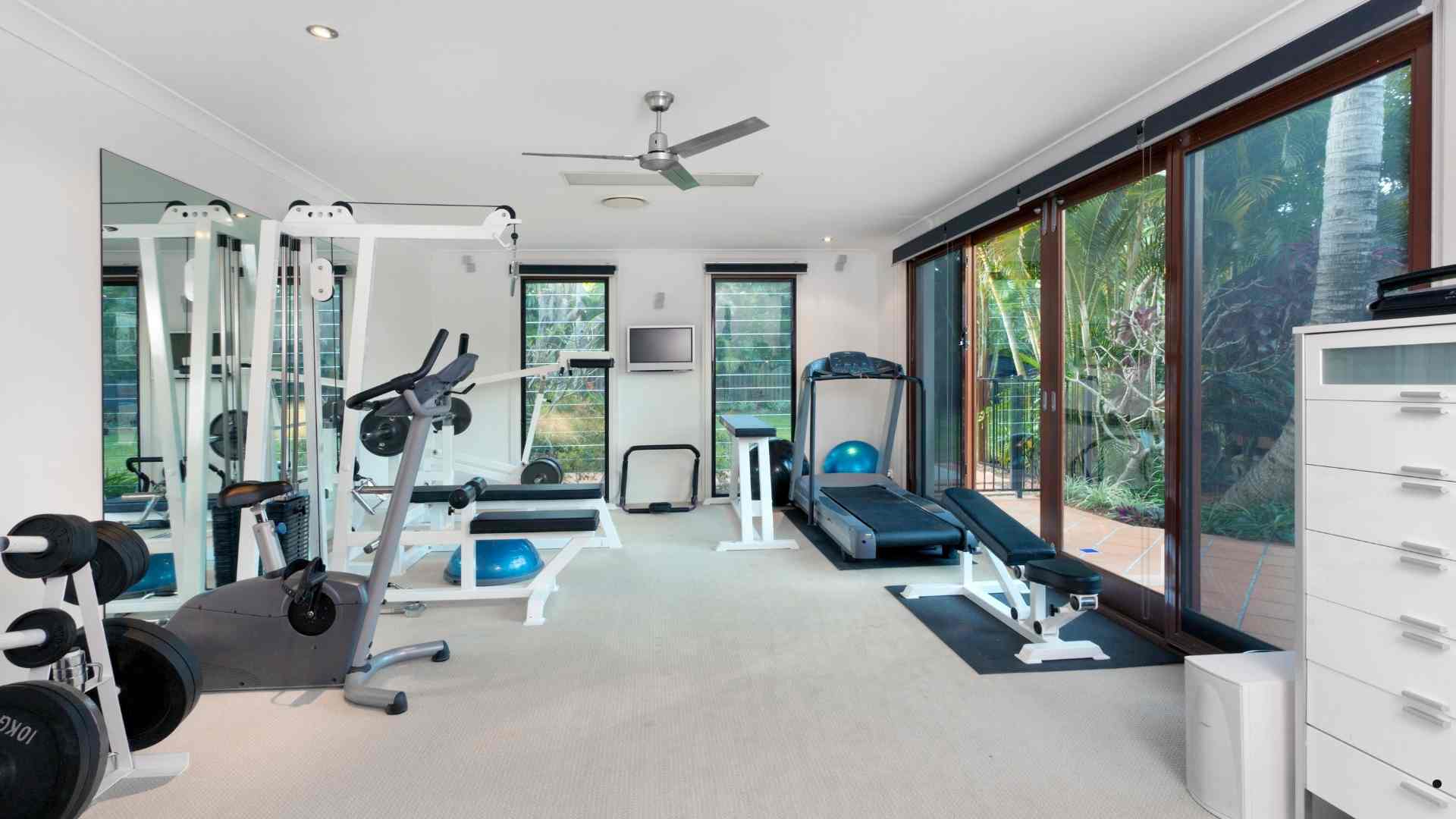How to Set Up a Budget-Friendly Home Gym: Setting up a home gym is a dream for many fitness enthusiasts. However, it’s easy to feel overwhelmed by the thought of expensive equipment, memberships, or complicated setups. The good news is that you don’t need a hefty budget to create a functional and effective home gym. With a little planning, smart choices, and creative thinking, you can build a space that helps you stay fit without breaking the bank. In this guide, we’ll walk you through the steps to set up a budget-friendly home gym in India.
1. Assess Your Available Space
The first step in setting up any gym is to figure out where you’ll work out. Your available space will determine the type of equipment you can buy. Don’t worry if you don’t have a large room; even a small corner in your living room, balcony, or bedroom can be transformed into a fitness zone.
Tips:
- A 5×5 feet space can easily fit a yoga mat, resistance bands, and dumbbells.
- Look for unused spaces like under the stairs or near windows for natural light.
2. Choose Multi-Use Equipment
When you’re on a budget, the key is to buy equipment that serves multiple purposes. Focus on versatility and practicality.
Budget-Friendly Essentials:
- Resistance Bands: These are affordable, space-saving, and can be used for a wide range of exercises.
- Dumbbells or Adjustable Weights: Instead of buying a variety of weights, opt for adjustable ones. They take up less space and are more cost-effective.
- Kettlebell: A single kettlebell can be used for strength training, cardio, and flexibility exercises.
- Skipping Rope: This is an excellent and inexpensive cardio tool that helps improve endurance and burns calories.
3. Invest in Quality Mats and Flooring
A comfortable, non-slip mat is essential for most exercises. It provides cushioning for floor workouts, protects your joints, and prevents injuries.
Budget Option:
- A basic yoga mat is a great choice for floor exercises like stretching, push-ups, or yoga. High-quality mats are available at affordable prices in India, especially from local sports stores or online platforms.
4. Utilize Bodyweight Exercises
You don’t always need fancy equipment to get fit. Many effective exercises rely on your body weight, making them free and convenient to do in your home gym.
Popular Bodyweight Exercises:
- Push-ups
- Squats
- Lunges
- Planks
- Mountain Climbers
- Burpees
These exercises target various muscle groups and can be easily done without any special equipment.
5. Buy Equipment on Sale or Second-Hand
If you want to add more equipment but are concerned about the cost, look for discounts, sales, or second-hand options. Many fitness enthusiasts sell gently used equipment online, often at a fraction of the original price.
Where to Look:
- Online Marketplaces: Websites like OLX, Quikr, and Facebook Marketplace offer second-hand gym equipment that can help you save money.
- Sales & Discounts: Many e-commerce platforms such as Amazon, Flipkart, and Decathlon offer seasonal sales with discounts on gym gear.
6. Make Use of Free Fitness Apps and Online Resources
Another great way to stay on track with your workouts without spending extra money is by using free fitness apps or YouTube channels. These resources provide guided workouts, training plans, and fitness tips.
Popular Free Fitness Apps:
- Nike Training Club
- FitOn
- MyFitnessPal (for tracking progress)
7. DIY Equipment Ideas
If you’re feeling creative, you can even make your own gym equipment at home.
DIY Ideas:
- Sandbag: Fill a durable bag with sand to use as a weight for exercises like squats and deadlifts.
- Water Bottle Dumbbells: Use water bottles filled with sand or water as makeshift dumbbells.
- Homemade Resistance Bands: You can use thick, stretchy fabric or rubber tubing as an affordable substitute for resistance bands.
8. Stay Consistent and Be Creative
Setting up a home gym is just the beginning. The most important part is staying consistent with your workouts. You can get creative with your exercises and routines, ensuring that you enjoy the process and stay motivated.
Tips:
- Set realistic fitness goals and track your progress.
- Change up your workout routine regularly to avoid monotony.
- Make your home gym environment motivating by adding mirrors, motivational quotes, or organizing your space neatly.
9. Create a Motivating Environment
One of the key factors in sticking to a home gym routine is the environment. A motivating and energizing atmosphere can make a huge difference. Even on a tight budget, you can make your workout space inspiring and pleasant to help keep you committed.
How to Create a Motivating Gym Environment:
- Lighting: If possible, set up your gym near a window to take advantage of natural light. Good lighting can enhance your mood and energy levels. If you’re working out at night, consider using LED strip lights or smart bulbs to create a fun, bright atmosphere.
- Mirrors: If you have extra space or an old mirror lying around, use it. Mirrors help with form and posture, and they make the space feel bigger and more professional. You can find inexpensive mirrors at local markets or online.
- Motivational Quotes: You don’t need to spend a lot on decor. Simple DIY projects like printing motivational quotes and sticking them on the walls can help you stay focused and positive.
- Plants: Adding a few small plants can help freshen up the air and add some vibrancy to your workout space, making it a more enjoyable environment.
10. Consider Your Fitness Goals and Tailor the Setup
A budget-friendly home gym doesn’t have to mean sacrificing your fitness goals. Whether you’re focused on building muscle, losing weight, improving endurance, or practicing yoga, you can tailor your equipment to match your specific goals.
For Strength Training:
- Focus on adjustable dumbbells, kettlebells, and resistance bands. These tools are excellent for muscle-building exercises such as bicep curls, squats, chest presses, and deadlifts.
- A pull-up bar can be an affordable addition for upper body strength, targeting your back, shoulders, and arms.
For Cardio:
- A skipping rope is one of the most affordable and effective cardio tools that you can use in small spaces. It improves cardiovascular health, coordination, and agility.
- Consider a mini exercise bike or a foldable treadmill for space-saving and low-cost options.
- If you prefer running outside, make use of nearby parks or walk/jog around your locality to avoid buying an expensive treadmill.
For Flexibility and Balance:
- A good quality yoga mat or balance ball can be great for improving flexibility and balance. Invest in a set of yoga blocks to further enhance your practice and make poses more accessible.
- You can also buy a foam roller to aid muscle recovery and reduce soreness after intense workouts.
11. Make Use of Local and Affordable Brands
While brands like Decathlon and Nike are well-known for fitness gear, you don’t always have to choose international names to get quality equipment. India has several local brands offering affordable, high-quality gym products, from dumbbells to yoga mats.
Popular Budget-Friendly Fitness Brands in India:
- Cannon Sports
- Strauss
- Khelkit
- RDX Sports
These brands often have sales or provide budget-friendly options for various fitness products, including resistance bands, dumbbells, and exercise balls. Check for local sports stores or online stores that specialize in Indian-made fitness products.
12. Save on Gym Memberships by Utilizing Community Resources
If you enjoy the social aspect of a gym but can’t afford a membership, consider other community resources. Parks and open spaces are often ideal for outdoor fitness activities like running, bodyweight exercises, and group workouts.
Ideas for Community-Based Fitness:
- Outdoor Workouts: Many parks and gardens in cities across India offer ample space for walking, jogging, or even group fitness classes.
- Fitness Meetups: Look for local fitness groups on social media platforms like Facebook or Instagram. Many fitness enthusiasts host free meetups for yoga, aerobics, or outdoor runs.
- Community Events: Keep an eye out for health and fitness events or free workout classes organized by local community centers, NGOs, or fitness groups.
13. Track Your Progress and Adjust Your Plan
A successful home gym routine isn’t just about having the right equipment; it’s also about keeping track of your progress. Whether you’re training for strength, endurance, or flexibility, measuring your progress will help keep you motivated and on track toward your fitness goals.
Ways to Track Your Progress:
- Fitness Apps: Apps like MyFitnessPal and Strava can help you log workouts, track nutrition, and monitor your progress.
- Journaling: A simple notebook or planner where you can record sets, reps, weight, or time can be an excellent way to stay on top of your routine.
- Progress Photos: Taking monthly photos of your progress can be motivating, especially when you start noticing physical changes from your hard work.
14. Stay Consistent with Your Routine
Consistency is key to any fitness journey, but sticking to a routine at home can be challenging at times. One of the main advantages of a home gym is that you can work out whenever you want, but that also means you’ll need to be self-disciplined.
Tips for Staying Consistent:
- Set a Routine: Try to work out at the same time each day so that it becomes a habit. Even if it’s just for 20-30 minutes a day, consistency is what will help you see results.
- Find Accountability: Share your fitness goals with a friend or join a fitness community online. Regular check-ins with someone else can keep you on track.
- Mix Things Up: Keep your routine varied by switching up exercises, adding new equipment, or trying different workout styles. This keeps your workouts exciting and prevents you from hitting a plateau.
FAQs: How to Set Up a Budget-Friendly Home Gym
1. Can I set up a home gym with just ₹10,000? Yes, you can! With careful planning, a ₹10,000 budget is sufficient to buy essential items like a yoga mat, resistance bands, and dumbbells. You can also opt for second-hand equipment to save more.
2. How do I choose the right space for my home gym? You don’t need a large space. A small room or even a corner of your living room or bedroom can work perfectly. Ensure the area is well-ventilated and has enough space for basic movements like squats or stretches.
3. Are online workout programs worth it? Yes! There are many free and affordable online fitness programs available that can help guide your workouts and keep you on track. Apps like Nike Training Club and YouTube channels offer amazing free resources.
4. What is the most important equipment for a home gym? If you’re on a budget, resistance bands, dumbbells, and a yoga mat are the most important items. They are versatile, affordable, and provide a full-body workout.
5. How can I stay motivated to work out at home? Set clear fitness goals, create a routine, and track your progress. Keep your workout area clean and inspiring. You can also follow fitness influencers or join online fitness communities to stay motivated.
6. How do I stay motivated to work out at home without external support? To stay motivated at home, set clear and realistic goals, create a fun workout playlist, and track your progress. Additionally, find an online fitness community or accountability partner to keep you engaged.
7. Can I build muscle with home gym equipment on a budget? Yes, building muscle with a budget-friendly home gym is definitely possible. By focusing on strength training exercises with dumbbells, resistance bands, and bodyweight exercises, you can achieve great results. Consistency, progressive overload (increasing intensity), and proper nutrition are key.
8. How can I ensure that my home gym stays organized? Keeping your space organized is essential for a functional home gym. Invest in inexpensive storage solutions like racks, baskets, or shelves to store your equipment neatly. A clean and organized space helps you stay motivated and reduces the risk of injury.
9. What are some good low-cost cardio exercises for home? Skipping rope, high knees, burpees, and mountain climbers are great, inexpensive cardio exercises you can do at home. Running or walking in place also serves as effective cardio if you don’t have a treadmill.
10. Is it worth buying second-hand gym equipment? Yes, buying second-hand equipment can be a great way to save money, especially for larger items like treadmills or weights. Just make sure to check the condition of the equipment before purchasing.
Conclusion
Setting up a home gym on a budget is all about being resourceful and smart with your purchases. With the right equipment, a little creativity, and consistency, you can build a fitness sanctuary at home. Keep it simple, stay motivated, and enjoy the journey toward better health and fitness!



